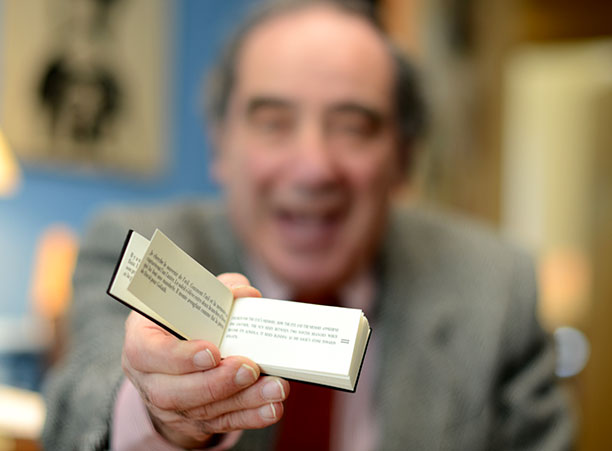In September 2013, the visual arts and literature intersected thanks to Maurice Géracht, Stephen J. Prior Professor of Humanities in the English department.
A book of hours and an accompanying sculpture titled “Heure” were produced by the L’Atelier Des Grames publishing house in Gigondas, France. French artist Anik Vinay created the miniature book and sculpture, and Antoine Graziani, French writer and poet, wrote the poem found in both figures. Géracht translated Graziani’s poem so both American and French audiences could read “Heure.”
Book of hours were popular prayer books in the medieval period. They were image-based texts, often no larger than a few inches in size, and generally created for family members and friends. For each hour of the day, a book of hours had a particular devotional. These one of a kind texts also served as a sort of calendar. They celebrated seasons by praising God, who created time and place. In modern times, the most celebrated book of hours is by German poet, Rainer Maria Rilke. Rilke’s most popular book of hours is a collection of love poems to God.
The story behind “Heure” starts when Géracht invited Vinay to present her work at the Iris and B. Gerald Cantor Art Gallery in 2009. While at Holy Cross, Vinay also worked with Susan Schmidt, associate professor of visual arts, and Susan Elizabeth Sweeney, associate professor of English. At the time, Schmidt and Sweeney were giving a joint course on printmaking and creating books. Vinay brought Graziani’s unpublished and untranslated version of “Heure” for the students in Schmidt and Sweeney’s class. Each student created an illustration for a particular hour in Graziani’s book using a printmaking technique. Géracht provided a literal translation of “Heure” for the students. Together the students created a small edition — at once a book and a readable, reconstructible paper sculpture.
Vinay showed Graziani the work she had done with Holy Cross students, and he was thrilled. But when Vinay set out to do her own edition and sculpture of Graziani’s book of hours, the poet wished for more of a poetic rather than literal translation. Although Géracht never thought of himself as much of a creative writer, he was nevertheless asked, and took on the task of writing a poetic translation of “Heure.”
“A poetic translation is very different than a literal translation; while you still have to get close to the literal text, you also have to capture the feel, the allusions, the imagery, and the rhythm of the poem,” Géracht explains. “You also have to be aware that English and French are very different languages. While I wanted it to be, on the one hand, faithful to the original, I wanted the translation to be English, ‘in the mouth and on the ear,’ as it were, and not French ‘Englished’.”
Graziani received the poetic translation of “Heure” a year later. Much to Géracht’s joy, Graziani loved the new translation.
“A Book of Hours, including ‘Heure,’ is essentially a collection of meditations offered for the reader's contemplation,” Géracht said. “Unlike Rainer Maria Rilke's or the medieval texts, Antoine Graziani's ‘Heure’ is not religious in a sectarian sense. But the meditations are deeply spiritual. They invite contemplations on the sublimity of the cosmos as well as on the specifics of nature at hand. The meditations also address the nature of human behavior.”
“Heure” is a limited edition 1½ inch by 3 inch book. There are 24 copies of this book and it is printed on hand made paper. The word “Heure” literally translates from French into the English word for “time.” The desk sculpture Vinay created is appropriately reminiscent of a sundial 7½ inches by 5 inches. There are only 14 copies of the sculpture, and it is made out of wood, paper, and leather.
A member of the Holy Cross faculty since 1966, Géracht specializes in 18th century English literature; English, American, French narrative traditions and narrative theory; 20th century visual arts and intersections between visual arts and literature.
Géracht, who served as the director of the study abroad program at Holy Cross for 18 years, is also co-president of the International Word and Image Conference, which yearly gathers international scholars in the humanities around a single theme, and since 2000 co-editor of Interfaces, the prize winning French/English word and image journal. He has been involved in the conference and the journal since their founding in 1986.
Related Information
